Asylum decisions - annual statistics
Data extracted on 22 April 2024. Data on decisions withdrawing protection status and resettled persons extracted on 05 June 2024.
Planned article update: April 2025.
Highlights
EU countries granted protection status to 409 485 asylum seekers in 2023, up 7% compared with 2022 (383 700).
Among the 409 485 asylum seekers who were granted protection status in 2023 in the EU countries, 43% received refugee status, 35% were given subsidiary protection, and 22% received humanitarian status.
Syrians, Afghans and Venezuelans were the main beneficiaries of protection status in the EU countries in 2023.
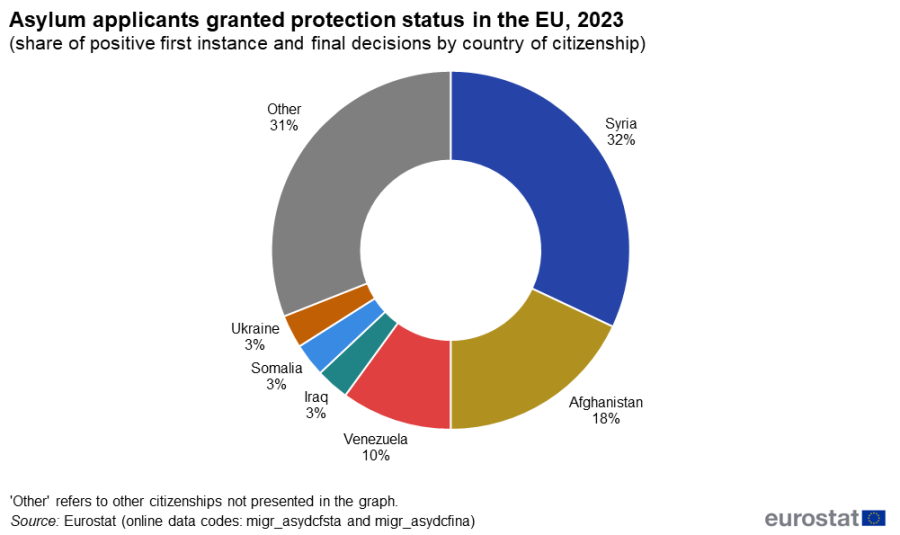
(share of positive first instance and final decisions by country of citizenship)
Source: Eurostat (migr_asydcfsta) and (migr_asydcfina)
This article outlines recent developments in relation to the decisions on applications lodged by asylum applicants in the European Union (EU). Asylum is a form of international protection given by a state on its territory. It is granted to a person who is unable to seek protection in their country of citizenship and/or residence, in particular for fear of being persecuted for reasons of race, religion, nationality, membership of a particular social group, or political opinion.
Asylum decisions can be categorised, according to the stage in the procedure when they are taken, into first instance decisions and final decisions following an appeal or review of first instance decisions. Depending on the outcome of the decisions, asylum applicants can be categorised as: granted refugee status, granted subsidiary protection, granted authorisation to stay for humanitarian reasons, and rejected applicants.
Full article
409 485 asylum seekers were granted protection status in EU countries in 2023
In 2023, 674 125 first instance decisions on asylum applications were made in the EU, and a further 191 530 final decisions following an appeal or review. A total of 865 655 asylum decisions were issued.
Decisions made at first instance resulted in 358 235 people being granted protection status, while another 51 250 people received protection status after an appeal or review. Overall, EU countries granted protection status to 409 485 asylum seekers at the first and final instances in 2023, up 7 % compared with 2022 (383 700). This is the highest number since the peaks recorded after the refugee crisis related to the war in Syria in 2016 and 2017 (Figure 1).
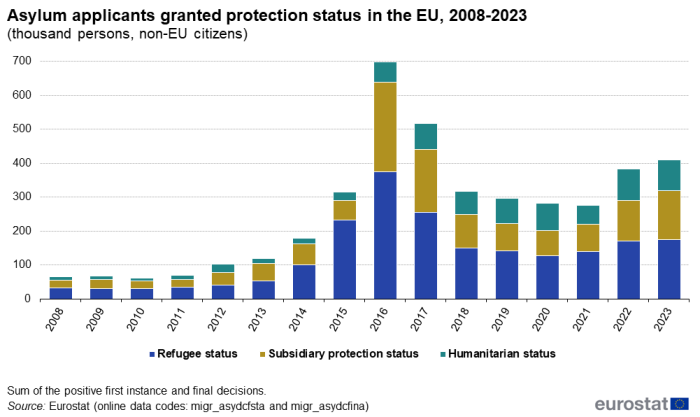
(thousand persons, non-EU citizens)
Source: Eurostat (migr_asydcfsta) and (migr_asydcfina)
In 2023, 43 % of asylum applicants received refugee status, 35 % were granted subsidiary protection, and 22 % received humanitarian status. Compared with 2022, the number of refugee statuses granted increased by 3 %, subsidiary protection increased by 20 %, and humanitarian status decreased by 3 %. Note that refugee and subsidiary protection statuses are defined by EU law, humanitarian status is specific to national legislation and is not applicable in some EU countries.
The highest number of people who received protection status in 2023 was reported by Germany (151 505, 37 % of the EU total), ahead of France (55 220, 13 %), and Spain (52 950, 13 %) (Figure 2). Together, these three countries granted 63 % of the protection requests at EU level.
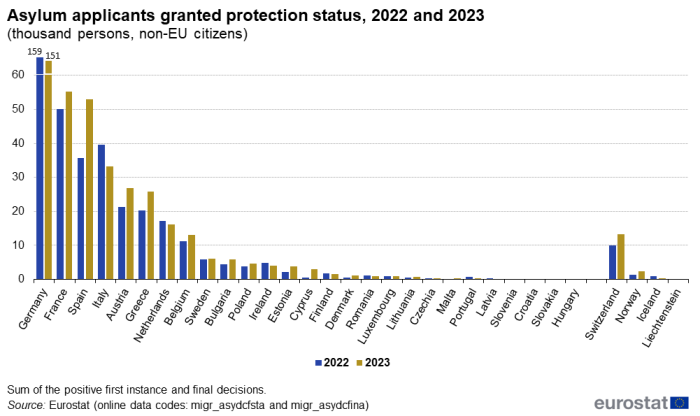
(thousand persons, non-EU citizens)
Source: Eurostat (migr_asydcfsta) and (migr_asydcfina)
In 2023, the largest group who obtained protection status in the EU were Syrians (32 % of the total number of people granted protection status in the EU, 130 160 persons) (Figure 3). They were followed by Afghans (18 %, 73 430), Venezuelans (10 %, 42 665), Iraqis (3 %, 12 040), Somalis (3 %, 11 675) and Ukrainians (3 %, 10 340).

(share of positive first instance and final decisions by country of citizenship)
Source: Eurostat (migr_asydcfsta) and (migr_asydcfina)
First instance decisions on asylum applications
In 2023, 358 235 asylum seekers were granted one of three positive outcomes of first instance decisions: 151 985 were granted refugee status (23 % of total first instance decisions), 130 015 were granted subsidiary protection (19 %) and 76 235 were granted humanitarian status (11 %) (Figure 4). The recognition rate at the EU level, i.e. the share of all positive decisions among the total number of decisions, was 53 % for first instance decisions.
More than 80 % of first instance decisions were positive in Estonia, Ireland and the Netherlands. Less than 20 % of positive first instance decisions were issued in Romania.
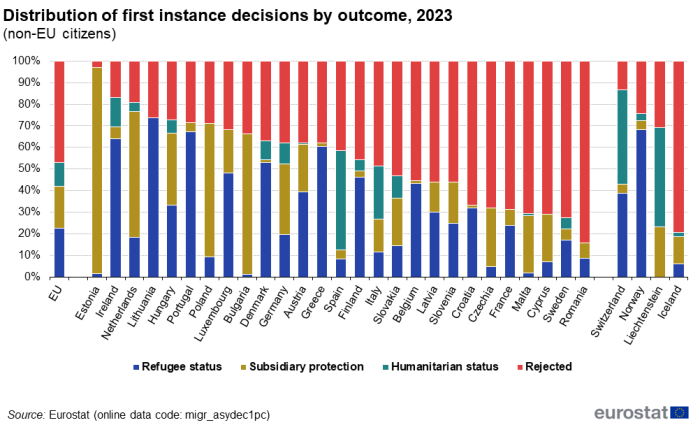
(non-EU citizens)
Source: Eurostat (migr_asydec1pc)
The largest group of asylum seekers who obtained protection status via first instance decisions in the EU in 2023 were Syrians (121 840, 34 % of positive first instance decisions). They were followed by Afghans (67 145, 19 %) and Venezuelans (42 340, 12 %).
The majority of Syrians (64 %) and Afghans (53 %) were granted protection status via first instance decisions in Germany, while almost all Venezuelans (96 %) were granted protection status in Spain.
Among the top 10 citizenships that received first instance decisions on asylum application in 2023, Syrians and Venezuelans (both 94 %) and Afghans (80 %) had the highest recognition rates (Figure 5).
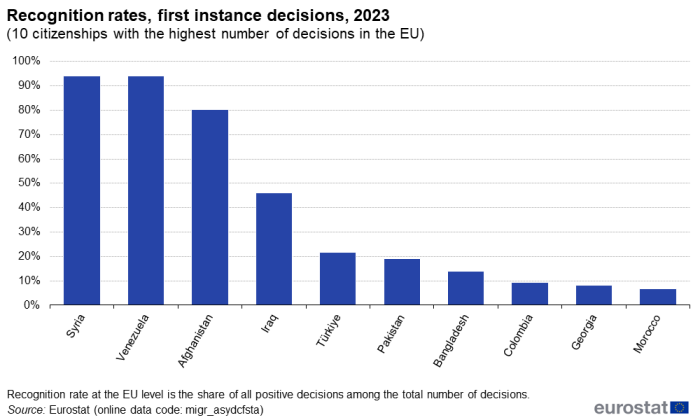
(10 citizenships with the highest number of decisions in the EU)
Source: Eurostat (migr_asydcfsta)
Final decisions taken on appeal or review
In 2023, 51 250 asylum seekers were granted one of three positive outcomes at final instance following an appeal or review; 23 535 were granted refugee status (12 %), 12 825 were granted subsidiary protection (7 %) and 14 895 were granted humanitarian status (8 %) (Figure 6). The recognition rate at EU level was 27 % for final decisions.
All the final decisions issued in Slovakia were positive. No positive final decisions were issued in Portugal and less than 10 % of positive final decisions were issued in Cyprus, Malta, Slovenia, Estonia, Poland, Greece, Sweden, Spain, Luxembourg and Czechia. No final decisions on asylum applications were issued in Hungary.
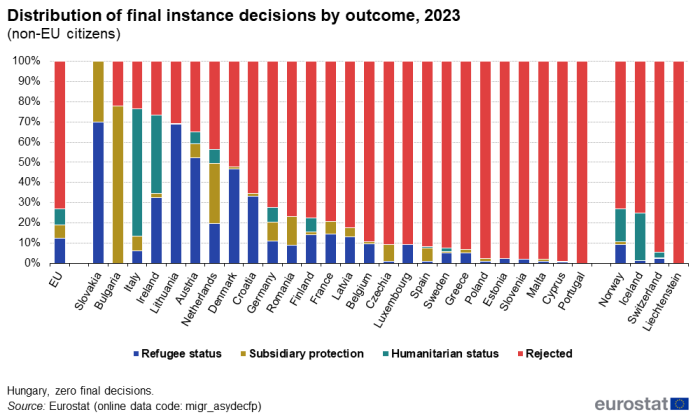
(non-EU citizens)
Source: Eurostat (migr_asydecfp)
The largest group who obtained protection status on appeal or review in the EU in 2023 were Syrians (8 320, 16 %). They were followed by Afghans (6 285, 12 %) and Nigerians (3 705, 7 %). Syrians (60 %) and Afghans (41 %) were granted protection status through final decisions mainly in Germany, while the majority of Nigerians (70 %) were granted protection status through final decisions in Italy.
Among the top 10 citizenships that received final instance decisions on asylum application after an appeal or review in 2023, the citizenships with the highest recognition rates were Syrians (79 %), Afghans (46 %) and Iranians (43 %) (Figure 7).
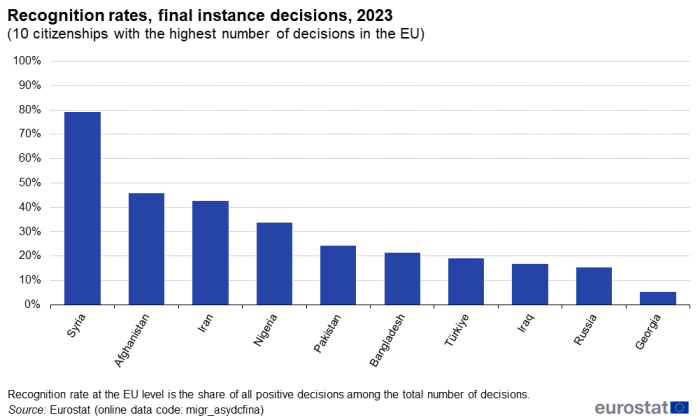
(10 citizenships with the highest number of decisions in the EU)
Source: Eurostat (migr_asydcfina)
Decisions on asylum applications lodged by unaccompanied minors
In 2023, based on available data, 15 655 first instance decisions on asylum applications lodged by unaccompanied minors were made in the EU, and a further 1 275 final decisions following an appeal or review. A total of 16 930 asylum decisions on unaccompanied minors were issued.
Decisions made at first instance resulted in 12 890 unaccompanied minors being granted protection status, while another 400 received protection status after an appeal or review. Overall, EU countries granted protection status to 13 290 unaccompanied minors seeking asylum in 2023.
Across the EU countries, Germany issued the most positive decisions on applications lodged by unaccompanied minors (5 875 persons, 44 % of positive decisions lodged by unaccompanied minors), followed by the Netherlands (1 860, 14 %), Greece (1 175, 9 %), Belgium (955, 7 %) and Italy (950, 7 %) (Figure 8).
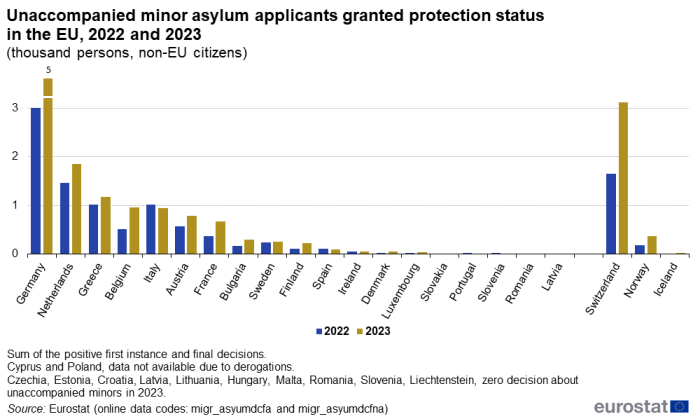
(thousand persons, non-EU citizens)
Source: Eurostat (migr_asyumdcfa) and (migr_asyumdcfna)
The main beneficiaries of protection status among unaccompanied minors seeking asylum in the EU countries were Syrians (5 710 persons, 43 % of positive decisions lodged by unaccompanied minors), and Afghans (4 125, 31 %).
Decisions withdrawing protection status
Member States may decide to withdraw protection status when new elements or findings arise indicating that there are reasons to reconsider the validity of protection. Decisions are taken by the competent administrative or judicial bodies either at first instance or on appeal (final decision).
In 2023, EU countries took 6 995 decisions withdrawing protection status granted at first instance and a further 2 855 decisions withdrawing protection status granted at final instance. The highest number of decisions withdrawing protection status granted at first instance was reported by Germany (2 030, 29 % of the EU total) and the Netherlands (1 060, 15 %) (Figure 9). The highest number of decisions withdrawing protection status granted at final instance was reported by the Netherlands (1 115, 39 % of the EU total) and Germany (780, 27 %).
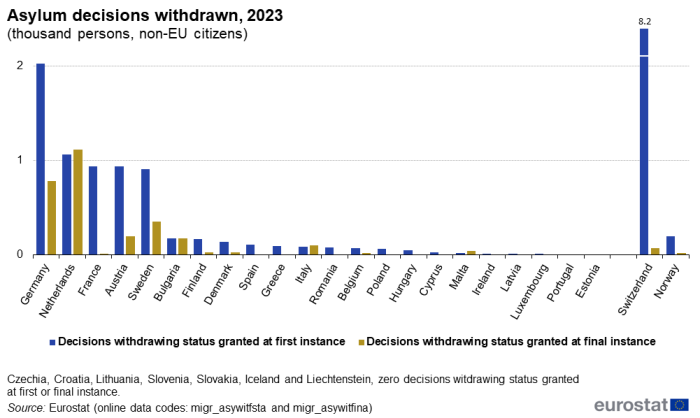
(thousand persons, non-EU citizens)
Source: Eurostat (migr_asywitfsta) and (migr_asywitfina)
Resettled persons
Resettlement[1] to the European Union, on request by UNHCR, is the transfer of vulnerable persons from third countries to EU countries, where they are admitted and granted the right to stay and any other rights comparable to those granted to beneficiaries of international protection.
In 2023, 13 960 persons were resettled to the EU countries, 25 % less compared with 2022 (18 555).
The highest number of resettled persons was reported by Germany (4 975, 36 % of the EU total), ahead of France (2 825, 20 %), Italy (1 645, 12 %) and Finland (1 330, 10 %), accounting for 78 % of all resettled refugees in the EU countries (Figure 10).
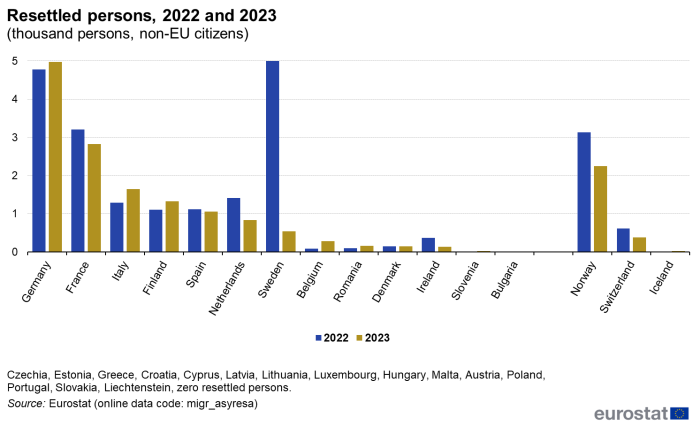
(thousand persons, non-EU citizens)
Source: Eurostat (migr_asyresa)
In 2023, the largest group of resettled persons were Syrians (7 635 persons, 55 % of all persons resettled to the EU), followed at a distance by Afghans (2 115, 15 %), citizens of the Democratic Republic of the Congo (1 020, 7 %) and Sudanese (905, 6 %).
The main countries of previous residence of resettled persons were Türkiye (2 525 persons, 18 % of all resettled persons to EU), Lebanon (1 835, 13 %) and Egypt (1 485, 11 %).
Persons were resettled on the EU territory based on a decision on refugee status (6 745 persons, 48 % of all persons resettled to the EU), on subsidiary protection (685, 5 %) and other positive decisions (5 130, 37 %). For 1 405 persons (10 %), the type of status granted with the resettlement decision is unknown.
The resettlement of persons under the EU resettlement frameworks represented 14 % (1 960 persons) and under other resettlement frameworks 58 % (8 130) of all cases. For 3 870 persons (28 %), the resettlement framework is unknown.
Among the 6 570 resettled minors (persons under the age of 18), 45 persons were unaccompanied minors (1 % of resettled minors).
Source data for tables and graphs
Data sources
Eurostat produces statistics on a range of issues relating to international migration. Between 1986 and 2007, data on asylum was collected on the basis of a gentlemen’s agreement. Since 2008 data have been provided to Eurostat under the provisions of Article 4 of Regulation (EC) No 862/2007.
Data are provided to Eurostat with a monthly frequency (for asylum application statistics, including applications by unaccompanied minors), quarterly frequency (for first instance decisions) and annual frequency (for final decisions based on appeal or review and resettlement). The statistics are based on administrative sources and are provided to Eurostat by statistical authorities, ministries of the interior or related immigration agencies in the EU Member States.
Two different categories of persons should be taken into account when analysing asylum statistics. The first includes asylum seekers who have lodged a claim (asylum application) and whose claim is under consideration by the relevant authority. The second is composed of persons who have been recognised, after consideration, as refugees, or have been granted another kind of international protection (subsidiary protection), or were granted protection on the basis of the national law related to international protection (authorisations to stay for humanitarian reasons), or were rejected from having any form of protection.
Since the entry into force of Regulation (EC) No 862/2007, statistics on asylum decisions have become available for different stages of the asylum procedure. First instance decisions are decisions granted by the respective authority acting as a first instance of the administrative or judicial asylum procedure in the receiving country. By contrast, final decisions on appeal or review relate to decisions granted at the final instance of administrative or judicial asylum procedure and which result from an appeal lodged by an asylum seeker rejected in the preceding stage. Since asylum procedures and the number/levels of decision making bodies differ among the EU Member States, the true final instance may be, according to the national legislation and administrative procedures, a decision of the highest national court. However, the applied methodology defines that final decisions should refer to what is effectively a final decision in the vast majority of cases: in other words, once all normal routes of appeal have been exhausted and there is no possibility to appeal on the substance of the decision but only on procedural grounds.
Limitations on data availability affecting the information presented in this article:
- Data for unaccompanied minor asylum applicants granted protection status at first and final instance, for Cyprus and Poland, data not available due to derogations. EU aggregates computed from available data.
- Data for resettled persons by country of previous residence, for Spain, France and Switzerland, data not available.
- Data for resettled persons by legal framework, for Spain and France, data not available.
Presented values are rounded to the nearest 5.
Resettlement data relate to resettled persons who have actually arrived on to the territory of the Member State and not to selected persons who remain in the third country waiting for a transfer to the Member States or to persons covered by future resettlement commitments. Only resettled persons arriving into a Member State from a third country are counted. Transfers between Member State of asylum-seekers, refugees or persons enjoying subsidiary protection status are not included in this category
Context
The 1951 Geneva Convention relating to the status of refugees (as amended by the 1967 New York Protocol) has, for around 70 years, defined who is a refugee, and laid down a common approach towards refugees that has been one of the cornerstones for the development of a common asylum system within the EU. Since 1999, the EU has worked towards creating a common European asylum regime in accordance with the Geneva Convention and other applicable international instruments.
The Hague programme was adopted by heads of state and government on 5 November 2004. It puts forward the idea of a common European asylum system (CEAS), in particular, it raises the challenge to establish common procedures and uniform status for those granted asylum or subsidiary protection. The European Commission’s policy plan on asylum (COM(2008) 360 final) was presented in June 2008 which included three pillars to underpin the development of the CEAS:
- bringing more harmonisation to standards of protection by further aligning the EU Member States’ asylum legislation;
- effective and well-supported practical cooperation;
- increased solidarity and sense of responsibility among EU Member States, and between the EU and non-member countries.
In May 2010, the European Commission presented an action plan for unaccompanied minors (COM(2010) 213 final), who are regarded as the most exposed and vulnerable victims of migration. This plan aims to set-up a coordinated approach and commits all EU Member States to grant high standards of reception, protection and integration for unaccompanied minors. As a complement to this action plan, the European Migration Network has produced a comprehensive EU study on reception policies, as well as return and integration arrangements for unaccompanied minors.
A number of directives in this area have been developed. The four main legal instruments on asylum are:
- the Qualification Directive 2011/95/EU on standards for the qualification of non-EU nationals and stateless persons as beneficiaries of international protection, for a uniform status for refugees or for persons eligible for subsidiary protection;
- the Procedures Directive 2013/32/EU on common procedures for granting and withdrawing international protection;
- the Conditions Directive 2013/33/EU laying down standards for the reception of applicants for international protection;
- the Dublin Regulation (EU) 604/2013 establishing the criteria and mechanisms for determining the EU Member State responsible for examining an application for international protection lodged in one of the Member States by a third-country national (national of a non-member country) or stateless person.
EU operational and financial support has been instrumental in helping Member States to address the migration challenge. In particular, the European Commission offers Member States continued financial support under the Asylum, Migration and Integration Fund (AMIF). AMIF has effectively and successfully supported the Union's joint response to the migration crisis, while also providing a sign of solidarity to the Member States on the frontline.
In April 2016, the European Commission adopted a Communication (COM(2016) 197 final) launching the process for a reform of the CEAS. This included options for a fair and sustainable system for allocating asylum applicants among EU Member States, a further harmonisation of asylum procedures and standards to create a level playing field across the EU and thereby reduce pull factors inducing irregular secondary movements, and a strengthening of the mandate of the European Union Agency for Asylum (EUAA).
In May 2016, the European Commission presented a first package of reforms, including proposals for establishing a sustainable and fair Dublin system (COM(2016) 270 final), reinforcing the Eurodac system (COM(2016) 272 final) and establishing a European Agency for Asylum (COM(2016) 271 final).
In July 2016, the European Commission put forward a second set of proposals related to the reform of the CEAS, for example to establish a resettlement framework for the EU (COM(2016) 468 final) and a common procedure for international protection (COM(2016) 467 final) as well as a recast of the legislation on the standards for the reception of applicants for international protection (COM(2016) 465 final).
In March 2019, the European Commission reported on the progress made over the past 4 years and set out the measures still required to address immediate and future migration challenges (COM/2019/126 final).
In September 2020, the European Commission presented the New Pact on Migration and Asylum which was adopted by the European Parliament in April 2024. This pact provides a comprehensive approach that delivers a common European response to migration. It allows the EU to manage migration in a fair and sustainable way, ensuring solidarity between Member States while also providing certainty and clarity for people arriving in the EU and protecting their fundamental rights. The Pact on Migration and Asylum will ensure that Member States share the effort responsibly, showing solidarity with the ones that protect our external borders and with those facing particular migratory pressure, while preventing irregular migration to the EU. The Pact also gives the EU and its Member States the tools to react rapidly in situations of crisis, when Member States are faced with large numbers of arrivals or when a third-country or non-State entity tries to instrumentalise migrants in order to destabilise our Union.
Russia’s invasion of Ukraine
On 4 March 2022, the Council unanimously adopted an implementing decision introducing temporary protection due to the mass inflow of persons fleeing Ukraine as a consequence of Russia's invasion.
The activated Temporary Protection Directive provides special procedures to deal with mass inflows of displaced persons for the first time. Temporary protection is an exceptional measure to provide immediate and temporary protection to displaced persons from non-EU countries and those unable to return to their country of origin.
It applies when there is a risk that the standard asylum system is struggling to cope with demand stemming from a mass inflow, risking a negative impact on the processing of claims.
Requirements for reporting such statistics already exist in Article 4(1)(c) and 4(3)(e) of Regulation (EC) No 862/2007. They have been implemented for the first time with the transmission of data on international protection as follows:
- quarterly data starting first quarter 2022;
- annual data starting 2022.
Quarterly and annual data on temporary protection are available in the Eurostat database in the following datasets: quarterly data and annual data.
In addition, in order to respond to emerging data needs, in March 2022 Eurostat proposed a voluntary collection of more frequent and timely, in terms of data provisions, statistics on temporary protection starting from reference month March 2022. The following data are collected on a monthly basis with a deadline for provision set within one month of the end of reference period:
- monthly data on grants of temporary protection;
- monthly data on beneficiaries of valid temporary protection (stocks).
The respective monthly datasets are available in the Eurostat database here. Detailed analysis of temporary protection statistics can be consulted in the monthly article Statistics Explained article.
This data is usually compiled and transmitted to Eurostat by national ministries of the interior and/or immigration agencies.
Direct access to
- Asylum applications - monthly statistics
- Asylum applications - annual statistics
- Temporary protection for persons fleeing Ukraine - monthly statistics
- Statistics on countries responsible for asylum applications (Dublin Regulation)
- Enforcement of immigration legislation statistics
- Residence permits - statistics on first permits issued during the year
- Asylum (t_migr_asy), see:
- Asylum and new asylum applicants - monthly data (tps00189)
- Persons subject of asylum applications pending at the end of the month - monthly data (tps00190)
- Asylum and new asylum applicants - annual aggregated data (tps00191)
- First instance decisions on applications by type of decision - annual aggregated data (tps00192)
- Final decisions on applications - annual data (tps00193)
- Asylum applicants considered to be unaccompanied minors - annual data (tps00194)
- Resettled persons - annual data (tps00195)
- Asylum (migr_asy), see:
- Asylum and temporary protection indicators (migr_asyltpind)
- Asylum indicators (migr_asyind)
- First-time asylum applicants - per thousand persons (migr_asyapp1mp)
- First-time asylum applicants - % of total asylum applicants (migr_asyapp1pc)
- First-time asylum applications of unaccompanied minors - % of total first-time asylum applications of minors (migr_asyapp1up)
- Positive first instance decisions - per thousand persons (migr_asydec1p)
- Asylum decisions at first instance by type of decision - % of total decisions at first instance (migr_asydec1pc)
- Asylum decisions at final instance by type of decision - % of total decisions at final instance (migr_asydecfp)
- Temporary protection indicators (migr_asytpind)
- Beneficiaries of temporary protection by citizenship - per thousand persons (migr_asytpspop)
- Decisions granting temporary protection by citizenship - per thousand persons (migr_asytpfpop)
- Asylum and temporary protection indicators (migr_asyltpind)
- Temporary protection (migr_asytp)
- Decisions granting temporary protection by citizenship, age and sex - annual data (migr_asytpfa)
- Decisions granting temporary protection by citizenship, age and sex – quarterly data (migr_asytpfq)
- First instance decisions granting temporary protection by citizenship, age and sex – monthly data (migr_asytpfm)
- Beneficiaries of temporary protection at the end of the month by citizenship, age and sex – monthly data (migr_asytpsm)
- Decisions withdrawing temporary protection by citizenship and reason – quarterly data (migr_asytpwq)
- Temporary protection (migr_asytp)
- Temporary protection of unaccompanied minors (migr_asyumtp)
- Decisions granting temporary protection to unaccompanied minors by citizenship, age and sex – annual data (migr_asyumtpfa)
- Decisions granting temporary protection to unaccompanied minors by citizenship, age and sex – quarterly data (migr_asyumtpfq)
- Decisions granting temporary protection to unaccompanied minors by citizenship, age and sex – monthly data (migr_asyumtpfm)
- Unaccompanied minors benefiting from temporary protection at the end of the month by citizenship, age and sex – monthly data (migr_asyumtpsm)
- Decisions withdrawing temporary protection to unaccompanied minors by citizenship and reason – quarterly data (migr_asyumtpwq)
- Temporary protection of unaccompanied minors (migr_asyumtp)
- Applications (migr_asyapp)
- Asylum applicants by type of applicant, citizenship, age and sex - annual aggregated data (migr_asyappctza)
- Asylum applicants by type of applicant, citizenship, age and sex - monthly data (migr_asyappctzm)
- Persons subject of asylum applications pending at the end of the month by citizenship, age and sex - monthly data (migr_asypenctzm)
- Asylum applications withdrawn by citizenship, age, sex and type of withdrawal - annual aggregated data (migr_asywitha)
- Asylum applications withdrawn by citizenship, age, sex and type of withdrawal - monthly data (migr_asywithm)
- Asylum applicants having had their applications processed under the accelerated procedure, by age, sex and citizenship - monthly data (migr_asyaccm)
- Applicants having benefited from material reception conditions at the end of the reference year - annual data (migr_asymrca)
- Applications (migr_asyapp)
- Applications of unaccompanied minors (migr_asyum)
- Asylum applicants considered to be unaccompanied minors by citizenship, age and sex - annual data (migr_asyunaa)
- Unaccompanied minor asylum applicants by type of applicant, citizenship, age and sex - annual aggregated data (migr_asyumacta)
- Unaccompanied minors subject of asylum applications pending at the end of the month by citizenship, age and sex - monthly data (migr_asyumpctm)
- Asylum applications of unaccompanied minors withdrawn by citizenship, age, sex and type of withdrawal - annual aggregated data (migr_asyumwita)
- Asylum applications of unaccompanied minors withdrawn by citizenship, age, sex and type of withdrawal - monthly data (migr_asyumwitm)
- Unaccompanied minor asylum applicants having had their applications processed under the accelerated procedure, by age, sex and citizenship - monthly data (migr_asyumaccm)
- Applications of unaccompanied minors (migr_asyum)
- Decisions on applications and resettlement (migr_asydec)
- First instance decisions on applications by citizenship, age and sex - annual aggregated data (migr_asydcfsta)
- First instance decisions on applications by citizenship, age and sex - quarterly data (migr_asydcftq)
- Decisions withdrawing status granted at first instance decision by type of status withdrawn, citizenship and reason - annual aggregated data (migr_asywitfsta)
- Decisions withdrawing status granted at first instance decision by type of status withdrawn, citizenship and reason - quarterly data (migr_asywitfstq)
- Final decisions in appeal or review on applications by citizenship, age and sex - annual data (migr_asydcfina)
- Decisions withdrawing status granted as final decision in appeal or review by type of status withdrawn - annual data (asywitfina)
- Resettled persons by age, sex and citizenship - annual data (rounded) (migr_asyresa)
- Resettled persons by age, sex, citizenship and country of previous residence - annual data (migr_asyrescra)
- Resettled persons by age, sex, citizenship and decision - annual data (migr_asyresda)
- Resettled persons by age, sex, citizenship and resettlement framework - annual data (migr_asyrelfa)
- Decisions on applications and resettlement (migr_asydec)
- Decisions on applications of unaccompanied minors and resettlement of unaccompanied minors (migr_asydum)
- First instance decisions on applications of unaccompanied minors by citizenship, age and sex - annual aggregated data (migr_asyumdcfa)
- First instance decisions on applications of unaccompanied minors by citizenship, age and sex - quarterly data (migr_asyumdcfq)
- Decisions withdrawing status granted at first instance decision to an unaccompanied minor by type of status withdrawn, citizenship and reason - annual aggregated data (migr_asyumwifa)
- Decisions withdrawing status granted at first instance decision to an unaccompanied minor by type of status withdrawn, citizenship and reason - quarterly data (migr_asyumwifq)
- Final decisions in appeal or review on applications of unaccompanied minors by citizenship, age and sex - annual data (migr_asyumdcfna)
- Decisions withdrawing status granted as final decision in appeal or review to unaccompanied minors by type of status withdrawn, citizenship and reason - annual data (migr_asyumwfna)
- Resettled unaccompanied minors by age, sex and citizenship - annual data (rounded) (migr_asyumresa)
- Decisions on applications of unaccompanied minors and resettlement of unaccompanied minors (migr_asydum)
- Applications (migr_asyapp) (ESMS metadata file — migr_asyapp_esms)
- Decisions on applications and resettlement (migr_asydec) (ESMS metadata file — migr_asydec_esms)
Legislation
- the Qualification Directive 2011/95/EU on standards for the qualification of non-EU nationals and stateless persons as beneficiaries of international protection, for a uniform status for refugees or for persons eligible for subsidiary protection (Summary)
- the Asylum Procedures Directive 2013/32/EU on common procedures for granting and withdrawing international protection (Summary)
- the Reception Conditions Directive 2013/33/EU laying down standards for the reception of applicants for international protection (Summary)
- the Dublin Regulation (EU) No 604/2013 establishing the criteria and mechanisms for determining the EU Member State responsible for examining an application for international protection lodged in one of the Member States by a third-country national or stateless person
Notes
- ↑ In the EU context, a third-country national or stateless person who, on a resettlement request from UNHCR based on their need for international protection, is transferred from a third country to a Member State where they are permitted to reside with a refugee status or a status offering the same rights and benefits under national and Union law.